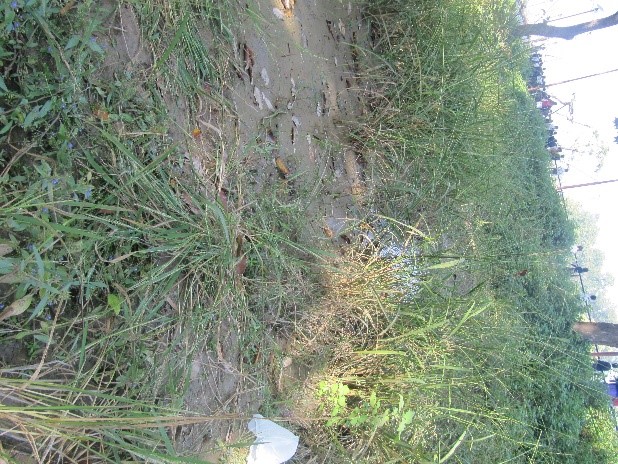स्थानीय कृषकले यो जंगली धानलाई कालो झौढा धान भन्ने गर्छन।
Under the wild rice exploration mission in Dhanghadi, Kailali, we Genebank team explored the wild rice in Dhanghadi on 13 Nov 2022. Many different places were visited and some of them were Gaurafanta, Malika Tole, Sipa Tole, Shiva Nagar, Airport route, Campus route, Bhatbhateni route, etc. We also talked with local people, farmers and chief of Agriculture Knowledge Center, Kailali. Earlier, there were O. nivara, O. rufipogan and Leersia hexandra in many places with large population. But this time, all three species were almost at the risk of extinction. Major factors of drastically decreasing the population of these rice species were 1. Expansion of road due to which water channel along the road side were collapsed, 2. Expansion of city areas and increased number of buildings, due to which wet lands were collapsed, and 3. Not giving due priority to wild rice. Farmers also reported that rainfall during maturity period of wild rice, moved seeds to many other cultivated areas. Farmers then removed such plants from the fields.
We then visited eastern site of Dhanghadi city, ie Jokhar Taal, which is protected by retaining wall. Just outside the Taal, along the retaining wall, we found three species growing together. They were O. nivara, Leersia hexandra and O. minuta (further verification is needed). Two species are commonly reported from Nepal, but O. minuta has not been reported. E-flora of Nepal (http://www.efloras.org/flora_page.aspx?flora_id=110) has shown O. minuta as synonym of O. officinalis. These two species are now considered separate species. We also asked farmers about these wild species. One farmer, Shiva Laxmi Joshi said that O. minuta is called Kaalo Jhaudaa Dhaan and O. nivara is called Jhaudaa Dhaan locally. Compare to earlier, populations of these wild rice are decreasing and now difficult to find out.
Oryza minuta was the tallest (2.5 m) among the rice species found in Nepal. Its panicle was spreading in nature producing small black grain with short awn. It is perennial type and was different than O officinalis, morphologically. There were about 50 hills only growing in about 20 sq m area in Jokhar Taal and we could not see this species in other areas. Number of tillers per hill was many. O. nivara and O. minuta were together in this Taal and O. minuta was very late compared to O. nivara. Seeds did not shatter easily as compared to nivara. Associated species were Saal tree, siru, sindure, madilo, and pirle jhaar. We collected seeds of O. minuta, O. nivara and Leersia hexandra (rice grass) from this Taal georeferenced of collection site: Altitude: 136 m, Latitude: 28o 42’ 19.4”N, and Longtidue: 080o 37’ 31”E) for conservation and rhizomes of O. minuta to grow in glasshouse in National Genebank.
With this O. minuta species, now Nepal has one cultivated rice species (O. sativa), five wild rice species (O. nivara, O. rufipogan, O. granulata, O. officinalis and O. minuta), one weedy rice (O. sativa f spontanea) and two wild relatives of rice (Leersia hexandra and Hygroryza aristata, called Asian watergrass). Among them, Nepal Genebank has conserved seeds of 8 species (see figure below).
These species are endangered and therefore need immediate action to conserve and manage their populations. Currently these species are out of boarder of Taal and therefore, these species should be transferred within a wall of Taal. For this, both rhizomes and seeds should be grown. Near to Taal, there is Botanical Garden and this Garden should consider these species for conservation. Further exploration, collection and verification (including molecular study) are necessary for these species from the same site. Wild rice conservation mission should be organized considering the establishment of field genebank of wild rice in some of NARC research stations and national parks. During expansion of road and buildings across the country, important species if found in such sites, should be repatriated and their seeds should be conserved in National Genebank. Along with wild rice, many wild relatives of agricultural genetic resources (AGRs) should be given due attention for conservation and utilization. National Genebank requests all stakeholders for their active role on conservation of all types of AGRs.

Seeds of rice species collected from Nepal and conserved in National Genebank

Seeds of Oryza minuta

Plant of O. minuta

Site of O. minuta in Jokhar Taal

O. minuta and O. nivara and associated plant species

Height of O. minuta (2.3 m)

Team with farmer in O. minuta population

Jokhar Taal in Dhanghadi
